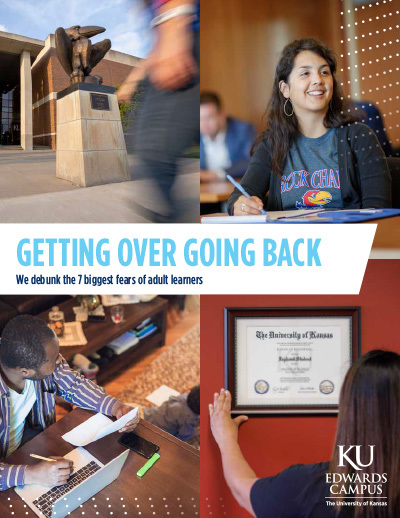Comprehensive confined space rescue training unit rolls out to firefighters

Kansas fire and rescue personnel are rolling out a safe and comprehensive, real-world confined space training program thanks to a $35,000 grant from ONE Gas Foundation. The donation has allowed Kansas Fire & Rescue Training Institute (KFRTI) to outfit its new, custom-made Confined Space Rescue Training Unit — a semi-trailer paid for with a $475,000 grant from the Department of Homeland Security. KFRTI is part of KU Lifelong & Professional Education and the donation was made possible through KU Endowment.
“ONE Gas is committed to safety and making our communities better places to live,” said Margaret Steele, community relations manager for Kansas Gas Service, a division of ONE Gas. “We’re grateful for the work of Kansas Fire and Rescue Training Institute and are proud to provide funding to support invaluable training to benefit our firefighting partners across the state, our employees and others who may enter confined spaces to work or perform rescues.”
According to The National Institute for Occupational Safety and Health (NIOSH), more than 60 percent of confined space fatalities are those attempting to rescue others. The term “confined space” is defined by specific characteristics:
- Large enough for someone to enter and perform work.
- Limited or restricted means for entry or exit.
- Not designed for continuous occupancy.
Confined spaces may include silos, hoppers, tanks, water supply towers, sewers, truck or rail tank cars, boilers, manholes, storage bins and a host of other locations. These spaces may be accessed by workers on the job or by adults or children not authorized to access them. The dangers that can be present in confined spaces include a toxic atmosphere, oxygen deficiency or enrichment, flammable or explosive elements, flowing liquids or excessive heat.
According to KFRTI Technical Rescue Program Coordinator Ben Green, there is a potential for confined space rescues to happen across the state all the time.
“From a tank filled with molasses to a kid in a storm drain, Kansas firefighters respond to all instances of people trapped in spaces where the environment within the confined space can cause injury, unconsciousness and even death,” Green said.
He said training for these different dangerous scenarios presents unique challenges, especially in providing safety for volunteer and career firefighters. KFRTI currently works with various entities to “borrow” confined space areas for training in order to simulate real-life scenarios. In a recent training at a water treatment plant, Green said they ran into some serious trouble.
“The last class we ended up having hydrogen sulfide (naturally found in some groundwater) gas enter the atmosphere,” he said. “When we came back from lunch, we could smell the rotten egg smell. Otherwise, we might not have noticed it. That gas is lethal if you’re exposed to even 100 parts per million.”
That experience prompted Green and others to research ways to find funds for a safer training unit, eventually leading to the Homeland Security grant. Now, with the ONE Gas Foundation donation, they have the state-of-the-art equipment they need to conduct confined space rescue training across the state.
“We’re a mobile training unit,” Green said. “So, this trailer will go all over the state, and we will likely be able to bring it to areas where confined space training was not available before.”
The equipment offers dozens of confined space rescue training opportunities in a safe, controlled environment conducive to learning. Green is especially excited about these features:
- Gas protectors have an instructor and student model so when a student goes in, the instructor can change the gas from outside.
- Adjustable ports so the instructor can leave it wide open where the student can go in a 20” x 30” hole and then have different end caps, with the smallest at 18” in diameter that they have to crawl through.
- There’s a chance for students to transition into three different levels within the trailer. Each level has a ramp of around 35 degrees that takes them from one floor to the other. Instructors can change the training unit to dictate to students what they are required to do and once they are inside the unit, quickly assign them to do a variety of rescue skills.
- The training unit has a heating and cooling system to help maintain an acceptable temperature, so training can take place throughout the hot summer months and longer in the fall.
The equipment KFRTI purchased with the ONE Gas Foundation donation includes:
- Breathing air supply hoses
- Rescue rope
- Urban Search and Rescue (USAR) technical rescue pack
- Vortex Rescue Tripod
- Rig tech pack
- Anchor straps
- Rescue spec carabineers (Rescue Spec)
- AZTEK kit (rope rescue rigging solutions)
- Long/Short prusiks (friction hitches)
- Bullex gas trainers (replicates a four-gas meter, simulates and “detects” gas clouds and leaks that can be set in realistic scenarios where firefighters are most likely to respond)
“I can add equipment right to this trailer,” Green said. “I can set this up, have a class and at the same time maintain a different ropes class, which will allow us to train more people and operate more efficiently.”
Once the equipment is installed in the training unit, Green said he will work with instructors to backward design a curriculum for various confined space rescue operations. He estimates the first students will begin training in the new unit by the end of March 2020.
Any fire department or training officer who wants to host a confined space rescue training class should contact KFRTI to set up available dates. Once the dates for trainings are set, they’ll post on the KULPE website and others can enroll in the class nearest them. Green said a minimum of 15 is required to make a class with a maximum of 21. Kansas firefighters only pay the $20 certification fee for the three-day training, which includes a fourth day for testing. Green noted that students must have already passed the introduction to technical rescue class before taking confined space training.
“We’ll be able to show firefighters how to rescue in confined spaces and how to get by with minimal equipment and with state-of-the-art equipment,” Green said. “We’ll be able to train firefighters to monitor their equipment without being reminded by an instructor. It will allow them to become much more proficient in using these gas detectors and monitors.”
The big benefit, Green said, is for the citizens of Kansas because they will have better-trained firefighters so they can respond to these types of situations and effectively rescue people.
“We [at ONE Gas] understand the common challenges and expenses associated with traveling to training classes,” Steele said. “In some instances, if the training isn’t brought to fire departments and volunteer firefighters, it wouldn’t be possible for them to participate. We believe this ‘traveling instruction service’ will provide a more cost-effective and convenient way to obtain critical confined space training, thereby helping to promote stronger and safer communities.”
KU Endowment is an independent, nonprofit organization serving as the official fundraising and fund-management organization for KU. Founded in 1891, KU Endowment was the first foundation of its kind at a U.S. public university.
Learn more about the Kansas Fire & Rescue Training Institute (KFRTI).





